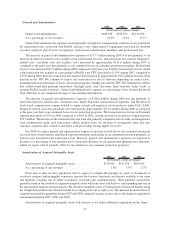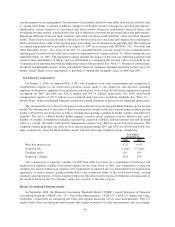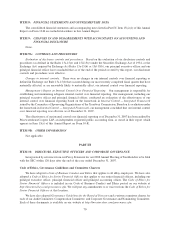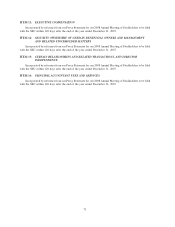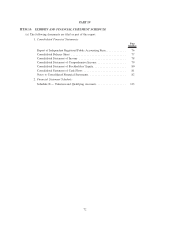eBay 2007 Annual Report Download - page 76
Download and view the complete annual report
Please find page 76 of the 2007 eBay annual report below. You can navigate through the pages in the report by either clicking on the pages listed below, or by using the keyword search tool below to find specific information within the annual report.
rate determined by our management. Our estimates of discounted cash flows may differ from actual cash flows due
to, among other things, economic conditions, changes to its business model or changes in operating performance.
Additionally, certain estimates of discounted cash flows involve businesses with limited financial history and
developing revenue models, which increase the risk of differences between the projected and actual performance.
Significant differences between these estimates and actual cash flows could materially affect our future financial
results. These factors increase the risk of differences between projected and actual performance that could impact
future estimates of fair value of all reporting units, particularly, our Communications reporting unit. We conducted
our annual impairment test of goodwill as of August 31, 2007 in accordance with SFAS No. 142, “Goodwill and
Other Intangible Assets.” As a result of this test, we concluded that the carrying amount of our Communications
reporting unit exceeded its fair value and recorded an impairment loss of approximately $1.4 billion during the year
ended December 31, 2007. The impairment charge includes the impact of the earn out settlement payment with
certain former shareholders of Skype and was determined by comparing the carrying value of goodwill in our
Communications reporting unit with the implied fair value of the goodwill. See “Note 3 — Business Combinations,
Goodwill and Intangible Assets” in the consolidated financial statements included elsewhere in this report for
further details. There was no impairment of goodwill or identifiable intangible assets in 2006 and 2005.
Stock-Based Compensation
On January 1, 2006, we adopted FAS 123(R), which requires a fair value measurement and recognition of
compensation expense for all share-based payment awards made to our employees and directors, including
employee stock options, employee stock purchases and restricted stock awards. Stock-based compensation expense
recognized for 2007 and 2006 was $301.8 million and $317.4 million, respectively. For 2005, stock-based
compensation expense of $31.8 million was recognized under previous accounting standards. See “Note 12 —
Benefit Plans” in the consolidated financial statements included elsewhere in this report for additional information.
We calculated the fair value of each option award on the date of grant using the Black-Scholes option pricing
model. The determination of fair value of share-based payment awards on the date of grant using an option-pricing
model is affected by our stock price as well as assumptions regarding a number of highly complex and subjective
variables. The use of a Black-Scholes model requires extensive actual employee exercise behavior data and a
number of complex assumptions including expected life, expected volatility, risk-free interest rate and dividend
yield. As a result, the future stock-based compensation expense may differ from our historical amounts. The
weighted-average grant-date fair value of stock options granted during 2007 and 2006 was $10.60 and $10.47 per
share, respectively, using the Black-Scholes model with the following weighted-average assumptions:
2006 2007
Year Ended
December 31,
Risk-free interest rate ........................................... 4.7% 4.5%
Expected life ................................................. 3years 3.5 years
Dividend yield ................................................ 0% 0%
Expected volatility ............................................. 36% 37%
Our computation of expected volatility for 2007 and 2006 was based on a combination of historical and
market-based implied volatility from traded options on our stock. Prior to 2006, our computation of expected
volatility was based on historical volatility. Our computation of expected life was determined based on historical
experience of similar awards, giving consideration to the contractual terms of the stock-based awards, vesting
schedules and expectations of future employee behavior. The interest rate for periods within the contractual life of
the award is based on the U.S. Treasury yield curve in effect at the time of grant.
Recent Accounting Pronouncements
In September 2006, the Financial Accounting Standards Board (“FASB”) issued Statement of Financial
Accounting Standards (“SFAS”) No. 157, “Fair Value Measurements” (“FAS 157”). FAS 157 defines fair value,
establishes a framework for measuring fair value and expands disclosure of fair value measurements. FAS 157
applies under other accounting pronouncements that require or permit fair value measurements and, accordingly,
66



